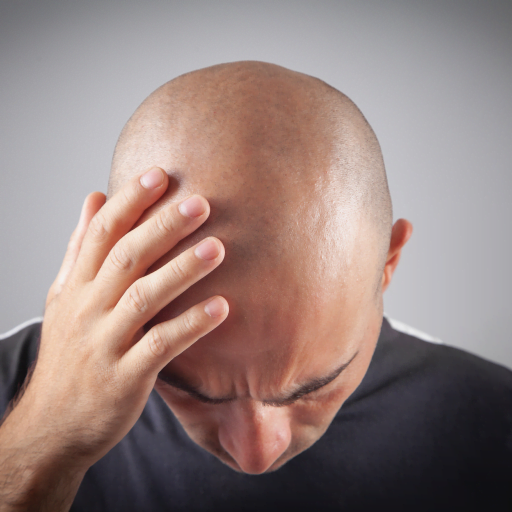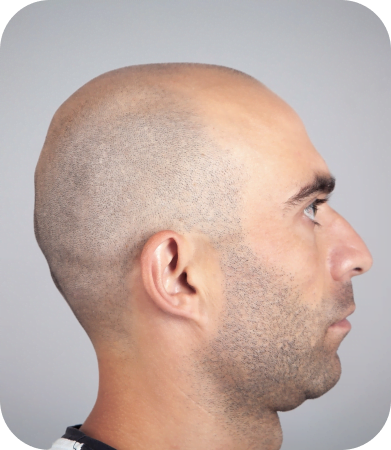Male Pattern Baldness and Hair Loss
Conveniently located to serve the Northern Virginia, Maryland and Washington D.C. metro areas.

Conveniently located to serve the Northern Virginia, Maryland and Washington D.C. metro areas.

Male pattern baldness, also known as androgenetic alopecia, is one of the most common types of hair loss affecting men. While balding is considered a natural part of getting older, premature or unexpected hair loss can suggest that you have a more serious underlying condition requiring treatment.
Are you dealing with thinning hair, bald spots, or a receding hairline? These visible signs of hair problems can result in psychological distress and a loss of self-esteem contributing to emotional stress, depression, and anxiety. Effective hair restoration treatments do actually exist, which can include hair transplants, laser and light therapies, topical creams, and oral medications.
Despite the challenges of losing hair as you age, you can feel more confident about how you look.
Male pattern baldness contributes to about 95% of hair loss cases in men. Clinically referred to as androgenetic alopecia, male pattern baldness results from hormone levels changing as a male ages. Besides hormone levels, males can lose their hair from factors such as genetics and aging.
Genetics can influence the expression of male pattern baldness. Genetics can also contribute to the shrinking of hair follicles, the tiny areas in the skin at the base of the hair. Subsequently, hair grows back shorter and finer until, over time, no new hairs grow.
No two cases of male pattern baldness are similar. Some men may experience a receding hairline above their forehead, while others may have a bald spot developing at the crown of their head. Still other men may find themselves losing hair on the tops of their heads.
Male pattern baldness generally starts at the hairline and recedes, moving backward, to create an M-shaped hairline. As time progresses, the hair on the scalp grows finer, shorter, and thinner, resulting in a U-shape, or horseshoe pattern, of hair along the sides of the head.
You can safely try to conquer your hair loss once you understand why it’s happening in the first place.

Various medical professionals believe that sex hormones contribute substantially to male pattern baldness. Male pattern baldness links to significantly high levels of dihydrotestosterone (DHT), which consists of a class of male sex hormones known as androgen. High amounts of androgen can result in increased hair growth as well as making you lose hair rapidly and earlier.
DHT can bind with hair follicle receptors in the scalp, resulting in shrinking and producing fewer hairs. When the DHT-sensitive follicles create fewer hairs, the area of the scalp with these follicles thins out. Eventually, these follicles produce thinner, shorter, and finer hairs, or they completely stop producing hair altogether.
High androgen levels that include DHT can end up shrinking hair follicles, shortening the hair growth cycle. This phenomenon also extends the time necessary for the follicles to grow new hairs once the old hairs fall out.
Some medical professionals believe that sensitivity to DHT influences male pattern hair loss. However, individuals can pursue treatment options to decrease the incidence of male pattern baldness by specifically targeting DHT. These treatments allow you to feel more confident and restore your sense of self-esteem.
Are you losing hair faster than before? Talk to a hair transplant specialist to find out more about causes that disrupt hair growth.
Are you experiencing male pattern baldness? Don’t lose hope. Several treatment options exist.
The treatment plan for androgenetic alopecia depends on the level of hair loss you’ve experienced and the quality of hair at the donor site. As long as you have reasonable expectations for how you can address your hair loss, you can work with a professional to find solutions that will work for your personal needs.
Have you already tried taking minoxidil and haven’t experienced significant results? Talk with your doctor about an alternative treatment for your hair loss such as finasteride. However, if both treatments don’t help restore your hairline, seek help from an experienced hair restoration specialist. Your specialist may recommend hair transplant surgery, such as follicular unit extraction.
The Hair Transplant Center – Virginia can discuss any of your concerns before suggesting hair transplant surgery. Complete our request form, provide your contact details and health history, and upload some photos.
Are you ready for a more youthful, natural-looking appearance? Contact us at The Hair Transplant Center – Virginia.
Schedule an initial consultation with one of our hair transplant surgeons. Our team can recommend a hair loss treatment that’s specifically designed for what you need. Schedule a consultation today and find out how to achieve the results you want for your hair loss.